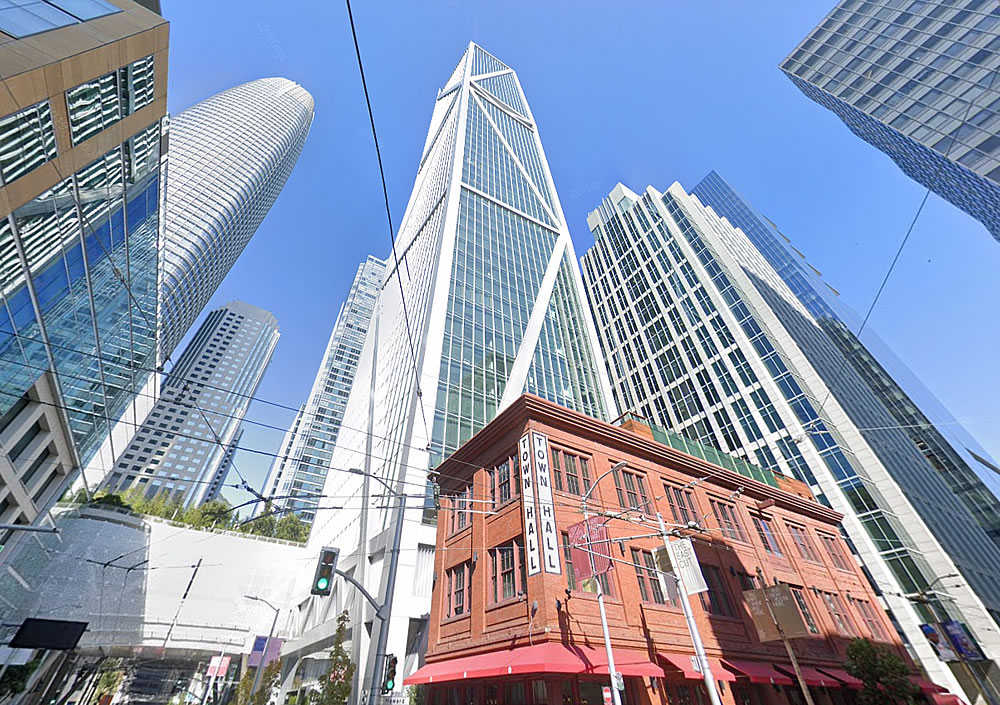While not recorded on the MLS, the three-bedroom, three-bath unit #60A at 181 Fremont Street appears to have been purchased for $5,772,672 in May of 2018, based on our review of its deed, as we first outlined a couple of years ago.
As we also outlined at the time, the 1,992-square-foot unit in the LEED Platinum tower, which sits on a foundation that reaches down to the bedrock below, features sweeping views of the city and bay, along with 9-foot ceilings, side-by-side parking for two cars and access to the poor-door-free tower‘s exclusive amenity floor (the office space below which was leased to Facebook).
Remodeled with “the finest materials [and] finishes” and returned to the market priced at $6.465 million in early 2019, the list price for the luxury unit was reduced to $5.950 million that May and then further reduced to $5.595 million that October while also being offered for rent at $20,000 per month.
Relisted for $5.595 million in February of 2020, the asking price for 181 Fremont Street #60A was reduced to $5.495 million that August and then to an even $5 million at the end of 2020.
Re-re-listed anew for $4.595 million seven months ago, the list price for the vacant and now virtually staged unit has just been further reduced to $3.995 million, a sale at which would be $1,777,672 or roughly 31 percent below its purchase/comp-setting price in May of 2018.
And for those running the numbers at home, the unit’s HOA fees are now running around $2,935 per month, not including a parking fee of $500 per month.
Yesterday, the re-sale of 181 Fremont Street #60A finally closed escrow with a contract price of $4.0 million, which was officially “over asking” according to all industry stats and aggregate reports but $1,772,672 or 30.8 percent below the price which was paid for the unit in 2018, prior to it being remodeled.








Foreign investors not into SF these days!
Anybody have the most recent rental comp for the building?
Well at least the Millennium Tower is leaning away, rather that towards 181 Fremont. Otherwise the sale price might have been even lower.
It was ridiculous to pay nearly $2,900/sf for it to begin with. The current $2k/sf is fair value considering the finishes and dated look.
Dated look?! “My, this interior is soooo 2019…”
By all means lets spend money and use energy ripping out months-old furnishings, tossing them aside and replacing them with something subjectively deemed “more stylish”. Carbon footprint? What carbon footprint?
Put words into other’s mouths much? Where did I suggest that the finishes get torn out???
Honest question — do we really think the 2018 sale was a real sale between unrelated parties? I often wonder if developers essentially sell to themselves (or a related party) to get a unit off the books and create a comp … then turn around and flip the property a few years later. My sense is that this unit has never actually been lived in.
Just curious. Maybe one of you know. Why place a big ‘ol TV there that breaks up the panoramic view? Is there a pole or other structural beam in that particular spot to be hidden? Seems like that would be the money shot for such an expensive apartment.
Structural beams at all corners
Column.
Might be structural column at the corner(s) of building. Not “pole” or “beam”. But that would be same for all units in the building. That alone probably wouldn’t explain selling for $1.7M loss. The awkward TV cabinet could be moved out of the way at minimal cost for almost pano views. The bedroom looks cramped and has wall covering that might not appeal to everybody. But that doesn’t normally justify selling for that magnitude of loss.
Unfortunately, removing the tv doesn’t do much. Using Google Earth, you can see how enormous (wide) the corner support columns are. In one of the photos the column is visible just to the left of the tv.
Don’t care for it when people hang flat panel TV over the fireplace either. But that’s more personal design taste. Point being you can move the TV anywhere you want. But the building colums are what they are, and its not like any seller in the building could move them for the buyer in any of the other units in the building. If a buyer can’t live with that, then its not the right buyer for that building. I don’t think that alone accounts for seller loss of $1.7M. The seller got beat up on price for other reasons, like falling values of tech companies on nasdaq and rising interest rates.
Yes (of course) there are columns – large ones – at the corners…they’re plainly visible in the exterior views. That would be true of almost any building (they could have smaller columns at other places on the perimeter and cantilever the corner, but regardless you’re always going to have some kind of obstruction)
If you look at the under-construction shots of this building you’ll see that the actual structural steel columns are half the width of their corresponding exterior vertical and diagonal details of the finished building. I guess the builder favored style over window space. Even so this TV cabinet is much wider than the finished exterior members.
Buildings with wraparound views like this would be a good place for one of those fancy retractable TVs where the screen rolls up into a low box when not in use.
Well it’s mix: if you blow up the phoot, you can see that
– to the right, the cabinet seems to extend quite a bit into the window (as evidenced by the exposed area being only about half what it is in the next one over), but
– to the left, it appears that the column itself is actually blocking the view….remember at the corners the area will be not just the w of a w*w column but {\sqrt {2}} *w)
Perhaps these “supercolumn” design don’t make much sense for residential ?? (or maybe go all in: set the columns 15-20 insdie the building and cantilever the floor beyond that)
Hardly any interior walls. Seriously, these units are terrible for people who own nice things that they would like to display.
The oversized bathroom appears to be almost as large as the smallish bedroom. And no separate dining area for $4 million (would anyone really host dinner guests in their $4 million condo at a high-top bar?).
Condos of this type were designed to sell to the first buyer. They weren’t designed to be lived-in.
You can thank the ADA for the excessively huge bathrooms in all new construction. There are many bedrooms smaller than bedrooms. Builders are being forced to use pocket doors due to space constraints.
Wheelie ?? I know of no ADA requirement for double sinks….and anyway, as can be seen this particular loo doesn’t seem to be ADA compliant.
Yeah no I’m not fan of the interior, but that wouldn’t explain $1.7M loss by seller. The buyer could more than afford to remodel for that amount. Something else is slowing buyer activity in this price range. Many of the buyers in this price range sell stock in tech companies to make down payment. Tech stocks have been crushed in 2022. Nobody wants to sell stock in falling market. Tech stock values need to recover before buyers come back. Other factor is rising interest rates if buyers are going to finance. These factors might not affect buyers in the ultra-high end range for whom price is no object.
It seems few people actually live there. This picture was taken in January 2022
https://preview.redd.it/zpeppttwfji81.jpg?width=640&crop=smart&auto=webp&s=fe215c04751794679609971011c2e11cf4561081
Of course they don’t. The recent sale price of this is more than twice the current market value of my home in Southern Marin and I wouldn’t trade straight-up. Never mind the HOAs, which I would imagine are more than $1,500/mo.
Recent problems at Millennium Tower and 33 Tehama support my long-held belief that it is best to buy-into condo complexes old enough that any construction issues are apparent.
Rereading the OP, I see that HOAs approach $3K.
But maybe not too old, lest they fall down (Champlain Towers) or you get saddled with a big special assessment for deferred maintenance.
One other problem in new construction is price discovery, where ascertaining fair value can be somewhat opaque for the buyer. Like maybe happened here.
Beautiful place and well bought. I would guess up 50% from here within 5 years.
So $3k/sf … yeah, right.
Is…. is that backsplash in the bathroom?
Great opportunity to open SF’s newest attraction
“Step right up to see the leaning tower of Millennium!”
So let me get this straight.
If the May 2018 buyer put $1,154,534 down on a 30yr fixed at 4.58 APR (average available rate in Apr of 2018) and assuming no additional payments, the Mortgage Calculator at Bankrate indicates that the amount of the loan still outstanding in Jul 2022 would be $4,288,671.78, or almost 7 percent less than the price which the unit was sold for.
Have to assume the seller paid cash in 2018, because if they financed, with the real estate agent’s commission, etc. they had to bring a pretty hefty check to the closing!
no chance they would have refinanced that 4.58 either.
people in that price range usually don’t need to finance.
I won’t dispute your contention, but why should we assume the wealthy buy in a different manner than the less-than-wealthy?? That is: why would a $1M house be bought by someone who only has a few hundered thousand in the bank and needs a loan, but a $7M one would (only) be bought by someone who has $7M sitting around ?? Why not someone who has only $2-3M ??
We shouldn’t assume it.
The comment you’re replying to is nonsense.
inthemarket’s comment was dead on.
People who buy in the luxury market don’t take loans and care about financing. Most pay all cash, or take a loan only to write off the 750k mortgage deduction, but the vast majority of luxury homes are bought with cash. We did that, and so did some other tech founders I know.
And just to be even more clear, the current down trend in housing in the 3-4m+ range has nothing to do with interest rates, (they really don’t care about paying an extra $250/500 a month) and everything to do with Tech stocks being down, where the bulk of their equity is. Once the nasdaq returns, SF luxury market will return.
I’ve seen buyers such as I guess thattechguy is do the following, many times. That’s buy something cash and then subsequently get a high net worth borrower loan from like a First Republic Bank at a rate that’s much lower than retail brick and mortar. It’s not that they need to get the mortgage, so to speak. It’s to preserve liquid capital for something else, or even more real estate elsewhere. To me that’s the typical playbook for such buyers.
People may need reminding that if you can pay $4M in cash, you have access to different sorts of lenders offering different interest rates than if you make a $200K down payment to a $1M purchase.
Rates were so cheap even for retail borrowers and even cheaper if you have money. Why would you sink cash into a house if banks were falling all over themselves to give you free money? Liquidating stock to make a cash home purchase gives you a tax hit and reduces your voting control. Saying the wealthy buy all cash is a thing posers say to impress other non-wealthy. Only exception is foreign buyers who can’t/don’t want to access the US financial system.
No article on the $29 million penthouse that close this week in Russian Hill?
2 condos sold together to same buyer, right?
$17M + $12M = $29M